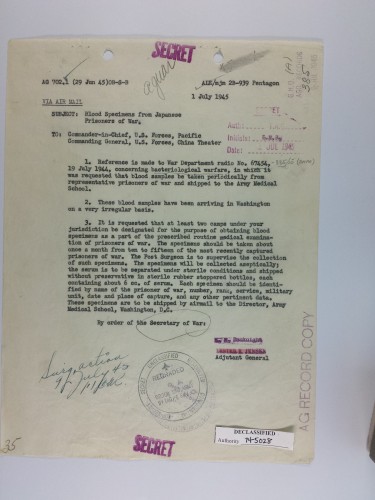Never trust the American government about weapons of mass destruction (WMD). This a lesson learned about American government behavior with the late 1990’s ‘Gulf War Syndrome’ scandals which eventually turned up the suppressed bombing of a 1991 Saddam Hussein nerve gas depot that trace-poisoned thousands of Gulf War Vets. See CIA analyst Patrick G. Eddington’s 1997 book Gassed in the Gulf: The Inside Story of the Pentagon-CIA Cover-Up of Gulf War Syndrome.
Little did I know that this thought about official American government WMD narratives applied for decades longer than the first Gulf War. In a past column “History Friday: A Tale of Balloon Bombs, B-29s and Weather Reports” I said the following about the Japanese strategic balloon bombing campaign —
American authorities — through the Chinese intelligence reports and captured Japanese documents — knew of the Japanese biological weapons program and greatly feared that the Japanese would use these balloons to deliver disease to the American heartland.
It turns out that the American War Department, and particularly Secretary of War Henry L. Stimson, was seriously interested in Japanese biological warfare experiments far earlier than the November 1944 through April 1945 Japanese strategic balloon bombing campaign. In fact, he had instituted a blood screening program of Japanese prisoners of war five months earlier to get an early warning of Japanese biological weapons (AKA bio-weapons).
See this 1 July 1945 follow War Department letter Ryan Crierie found recently in the US National Archives:

This letter was a follow up letter to a 19 July 1944 radio instruction that complained to both Generals MacArthur and Wedemeyer that they were not regularly following the 19 July 1944 War Department directive and directing them how to properly draw package and ship the desired blood samples to the Director of the US Army Medical School in Washington DC.
Given this recently uncovered background data, plus the dodgy behavior by American military prosecutors at MacArthur’s War Crimes tribunal in Manila to cover up the Japanese biological program from the American public for decades, it is easy to see why diplomatic historians like Gar Alperovitz started talking about great “Atomic Diplomacy” cover ups.
There _was_ a weapons of mass destruction cover up…just not one dealing with atomic bombs.
The first act of the Cold War wasn’t President Truman sending arms to stop a Communist takeover of Greece. It was his administration’s cover up of the Japanese biological weapons program. This, just by itself, is a good reason not to trust the American government on the subject of weapons of mass destruction. If they did it once, they will do it again…and have, as Patrick G. Eddington documented.
What was their motive?
>>What was their motive?
There were two.
1. Getting the Japanese Army to fully surrender and not go on a mass murder spree.
2. Denying the Japanese bioweapons research to the Russians.
The 2-year long Manila war cimes trial was the club over the Emperor to make him cooperate in accomplishing the demobilization.
After that, Truman and his people were “dirty” and everyone involved had an interest in furthering the cover up.
And note, the Russians knew all about the Japanese bioweapons program as they had over run the Manchurian bioweapons facility and accused the USA of bioweapons attacks in the Korean War.
The cover up was aimed at the American people and was not fully confirmed until the Cold War was over and many of the relevant records were declassified.
The Truman administration started protecting Nazi war criminals, including biowar criminals, months before we started doing so with the Japanese war criminals. See _Operation Paperclip: The Secret Intelligence Program that Brought Nazi Scientists to America_ by Annie Jacobsen.
Tom,
The Germans had the opportunity to surrender first.
The Japanese biowar program coverup had serious consequences for our troops in Korea. A friend of mine was a pathologist in Korea and they had terrible problems with hemorrhagic fever in the war . The Japanese had done extensive research on this problem before and the results were concealed from US medical corps folks during the war.
Epidemic hemorrhagic fever with renal syndrome was recognized for the first time in 1951 among United Nation troops (1). Since that time it has been known as Korean hemorrhagic fever (KHF) and has remained endemic near the Demilitarized Zone (DMZ) between North and South Korea. In recent years the disease has invaded the southern parts of the Korean peninsula and 100 to 800 hospitalized cases are clinically diagnosed each year (Table 1).
KHF is an acute infectious febrile, often fatal, otherwise self-limited, illness of viral etiology characterized by severe toxemia, widespread capillary damage, hemorrhagic phenomena and renal insufficiency (2).
Similar diseases to KHF as shown in Figure 1, have been described by Japanese from Manchuria (3,4,5), from the Soviet Union (6,7), from Scandinavia (8,9,10), from several countries in Eastern Europe (11) and recently from Japan (12).
In early 1940’s Japanese and Russians reproduced hemorrhagic fever by injection of urine and blood of the patients into monkeys (4) and volunteers. The injection of a suspension of Trombicula mite obtained from Apodemus agrarius into human caused hemorrhagic fever, and mites have been suspected as its reservoir(13). Many attempts have been made to isolate the causative agent of KHF and clinically similar disease.
Unit 731, and Japanese General Shiro Ishii, had advanced far beyond our capabilities in biological and gas warfare due to their ability to experiment on live human beings. These were mostly Chinese, and a few allied prisoners, or even Japanese soldiers if they got infected. We wanted this information so badly that we cut deals with those who committed these crimes. The practical outweighed the truth at this time. It is one of the fantasies of the “Good” war.
We also had a plan to gas Japan in 1945. It may have saved a lot of American lives, but both soldiers, generals, admirals, and civilians were against its use. (Thomas B. Allen, “Gassing Japan”.)